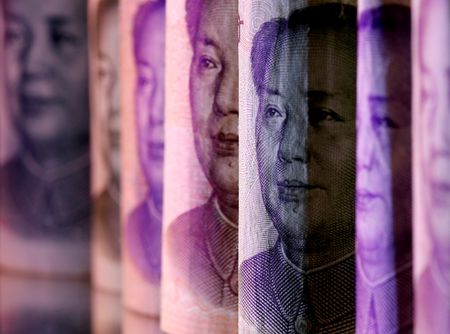SHANGHAI (Reuters) -China’s yuan extended its decline on Tuesday to a near 15-year low, following Monday’s sell-off in Chinese assets by global investors worried about Beijing’s policy direction, while Hong Kong and China stocks ended lower as a rebound petered out.
The onshore yuan finished the domestic session at 7.3085 per dollar, the weakest official close since December 2007. It followed a sharply weaker official midpoint set by the People’s Bank of China.
The offshore yuan weakened to as much as 7.3655 per dollar, a new low.
The yuan is suffering from “the double whammy of mounting capital outflow and PBOC’s CNY fixing guidance tweak,” Mizuho Bank strategist Ken Cheung wrote in a note to clients. He added that the end of the 20th Communist Party Congress “marked the beginning of the mega China sell-offs.”
However, the panic selling “was largely driven by sentiment and based on plenty of policy prediction and it could be overdone,” he said, referring to fears that under President Xi Jinping’s third leadership term, China will sacrifice economic growth for ideology and stick with its zero-COVID policy.
Hong Kong’s Hang Seng Index, which plunged 6.4% in the previous session, fell 0.1% to a 13-year closing low, wiping out earlier gains. The Hang Seng Tech Index closed 3% higher, after jumping as much as 6.1% following Monday’s market rout.
China stocks also ended in negative territories after giving up earlier gains.
The CSI300 Index fell 0.2%, while the Shanghai Composite Index ended roughly flat.
“Market sentiment on China equities is still weak because of the macroeconomic backdrop, and with the dynamic zero-COVID policy still in place,” said Pruksa Iamthongthong, senior investment director of Asian equities at abrdn.
But valuations are highly supportive following the recent market declines, so “we remain buyers of Chinese equities.”
TRADING BAND
In the currency market, the yuan almost hit the weak end of its daily trading band for a second consecutive session on Tuesday, despite government moves to ease depreciation pressure.
Regulators on Tuesday raised the cross-border macro prudential adjustment ratio for corporates and financial institutions, making it easier for domestic firms to raise funds from overseas markets, thus encouraging more capital inflows.
In addition, China’s foreign exchange regulator sent a survey to some banks late on Monday asking them about their positioning in the currency market, sources told Reuters, signs that authorities are concerned about the yuan’s depreciation.
Mizuho’s Cheung expects the PBOC to continue to narrow the gap between the yuan’s fixing and spot prices gradually to alleviate depreciation pressure, predicting the Chinese currency should start to find its footing below 7.4 level.
In both onshore and offshore yuan markets, volatility implied by 1-month options hit record highs on Tuesday.
(Reporting by Shanghai newsroom; Editing by Jacqueline Wong and Maju Samuel)

